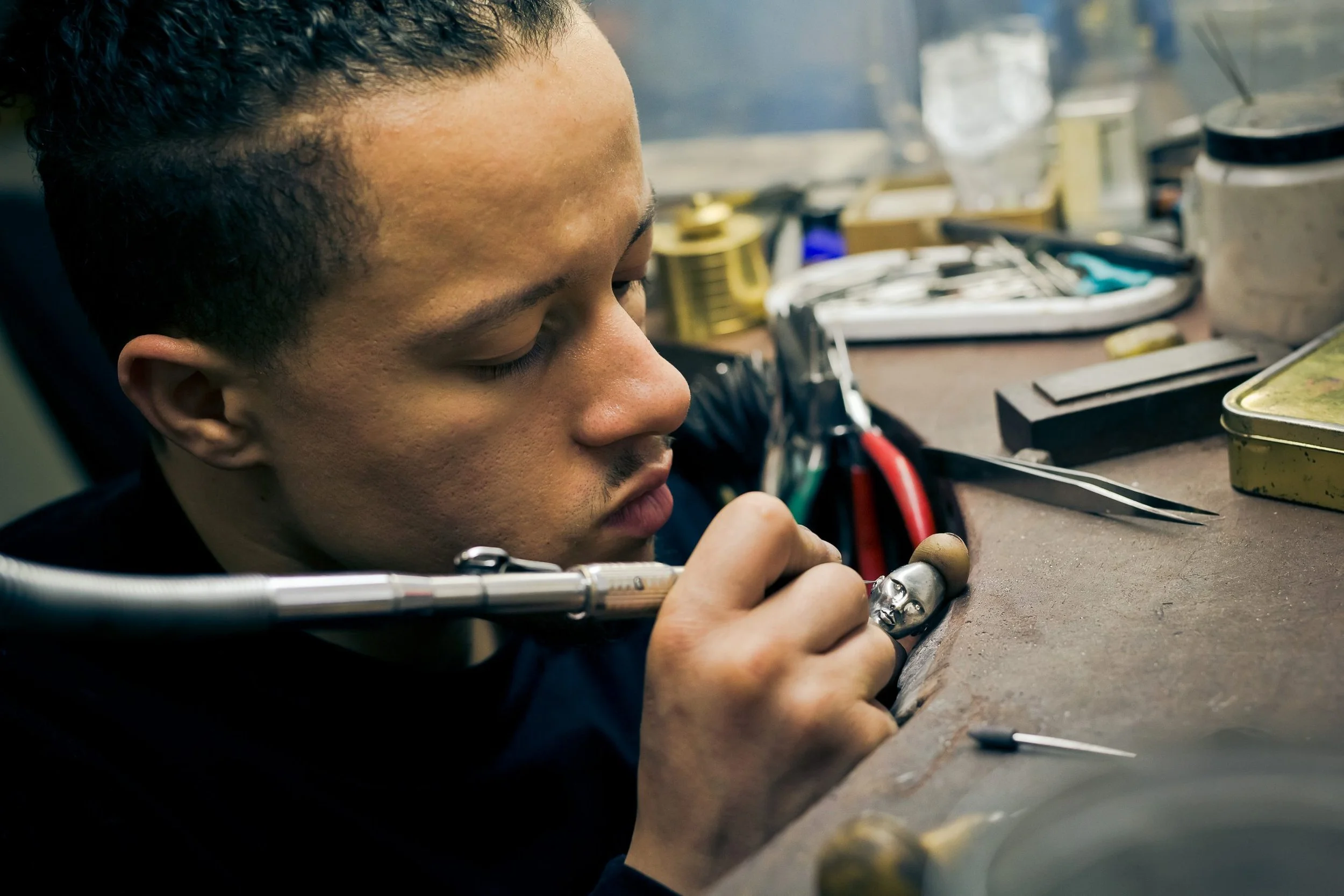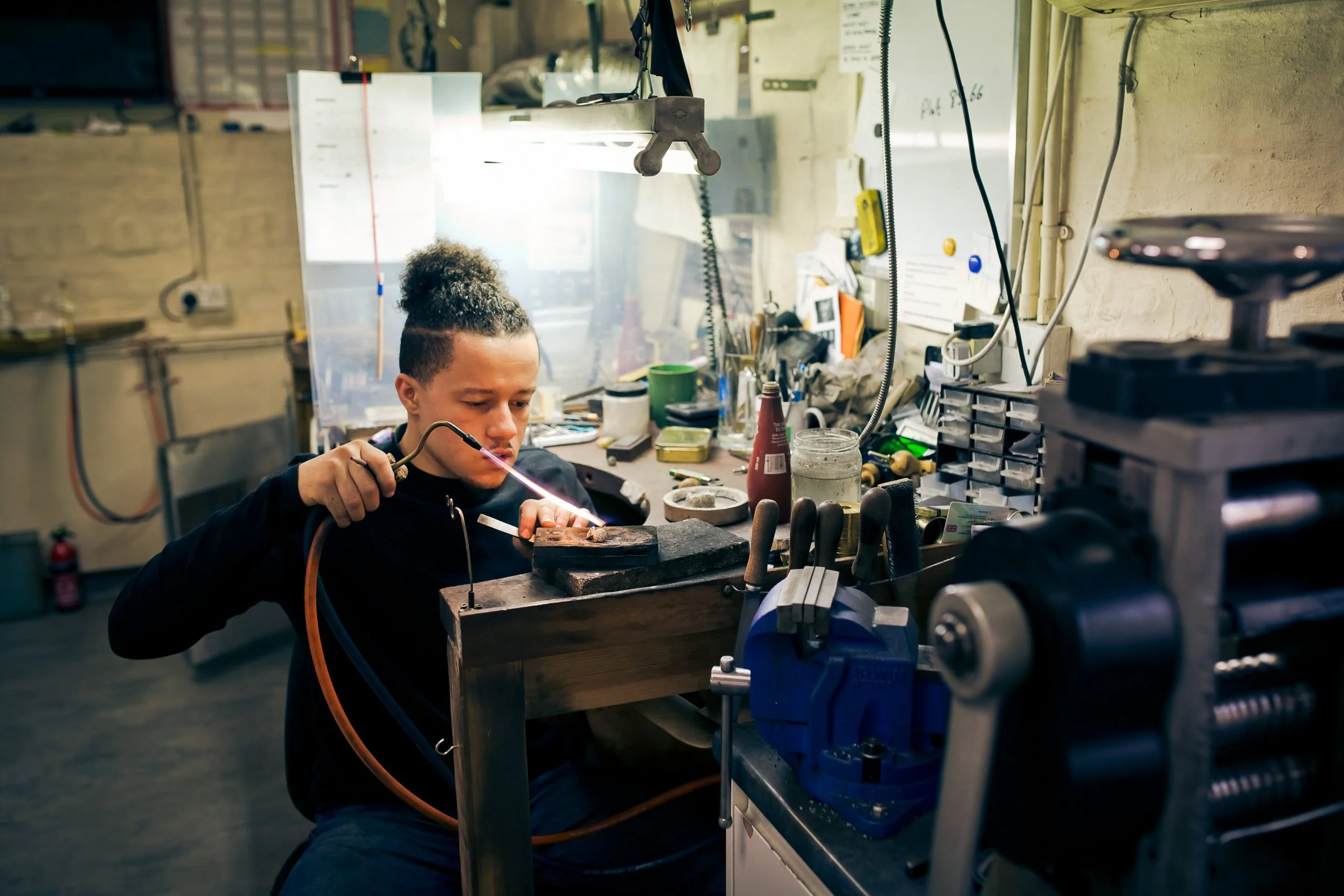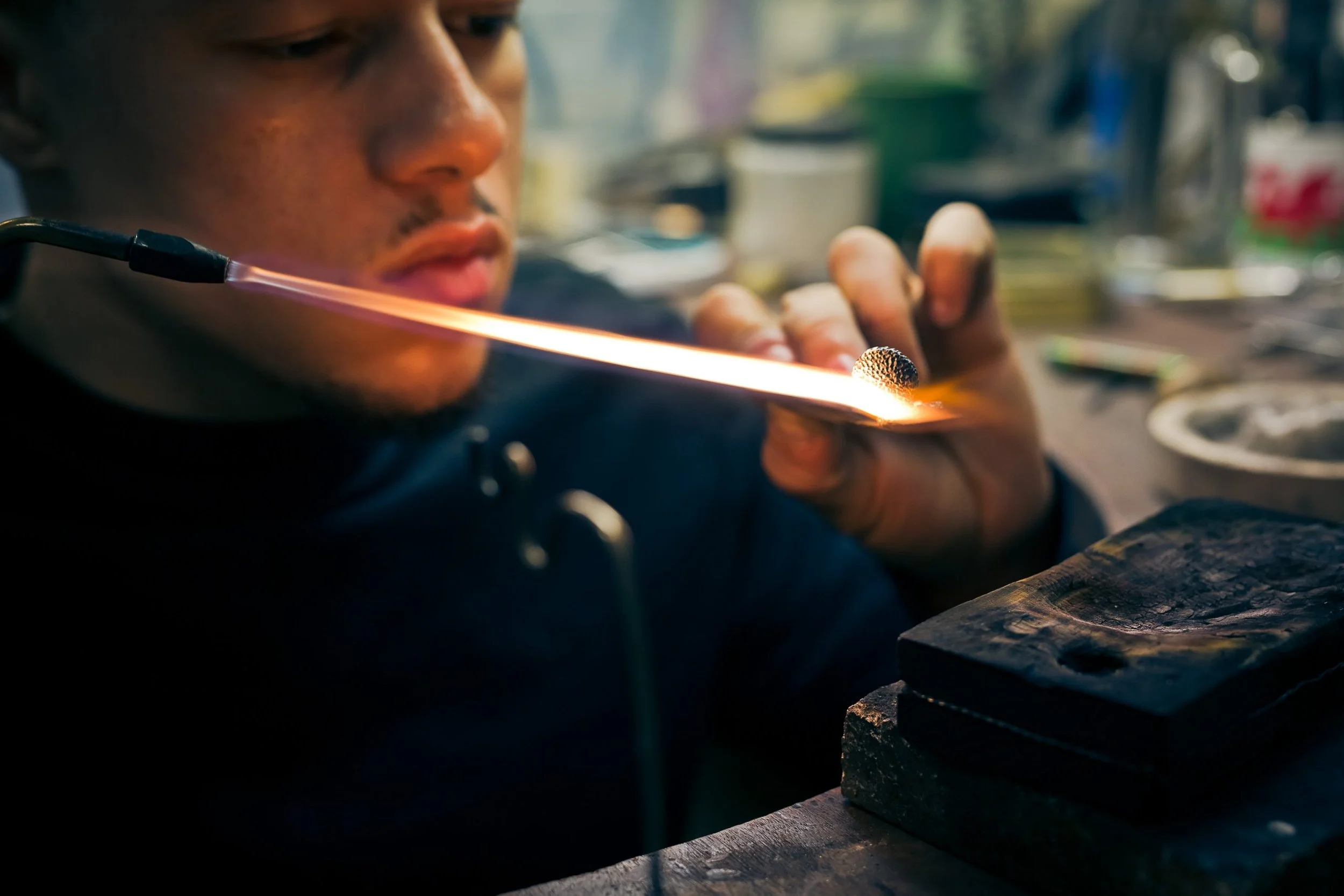Attitude and passion: the jewellery of Hugo Luis Johnson
“We have a rich and old history of jewellery in England that needs to evolve”. For his series on early career jewellers and silversmiths, writer Jonathan Foyle speaks with former Goldsmiths’ Company Apprentice and winner of the BBC’s ‘All that Glitters’ jewellery making competition in 2021 , Hugo Luis Johnson.
Passion is the great driver of mankind, for we are less rational creatures than we like to believe. To embark on a career, to partner, buy a house, to parent a child- each fundamental investment in life is driven less by evidenced strategic calculation than by emotional impulse.
Jewellery is made for those grand emotions and passions, even if the late Zsa Zsa Gabor admitted that “I never hated a man enough to give him his diamonds back”. The metals and stones that jewellers shape into private microcosms offer, on a basic level, the reassurance of unchanging beauty and order in a messy, complicated world. Beyond that, they might stir the sentimentalities of memory, or spark hope, represent a vow of commitment, love and generosity. Each exchange of crafted precious materials marks such a moment, and often lives beyond us, a witness of private bonds to future generations. Jewellery fits these emotional stations in life as snugly as a greased ring on a fat finger.
The point was amply made, although not without criticism, on BBC2’s ‘All That Glitters’, a recently broadcast competition between eight jewellers judged by celebrated industry luminaries Shaun Leane and Solange Azagury-Partridge. Like much television it traded on emotion. Introducing clients’ hopes and dreams, we meet a couple about to marry seeking a piece the bride might instantly feel a powerful connection to, and a man whose selfless Mum deserved a pendant to receive her MBE; of course, there were hugs galore, brimming pride, contained disappointment. The revelation of the winner caused Solange Azagury-Partridge to well up, and barely pronounce the victor’s name.
That name is Hugo Johnson.
Hugo, who makes pieces under the moniker ‘Hugo Luis’, impressed the judges through his design sensibility and exquisite finish but also for bouncing back from criticism. “Hugo responded really well… he just focused”, said Solange. And here’s the rub. This jeweller whose passion for his work rings out like a golden bell, ascribes his focus and resilience to cancelling emotion. “Tunnel-vision. That’s the state of mind to be in”, he says. And the Zen state he harnesses comes from a place you’ll never find jewellery: the arenas of martial arts combat.
As a boy, he and his older brother and two sisters were encouraged by their father Brian— a graphic designer and enthusiast of Taekwondo— to pursue mental discipline through harnessed strength, smooth movement, and myriad lightning-quick instinctive decisions. All are useful to the fighter, and the jeweller too, he says. “I think that for anyone at a young age, to have something to teach you discipline and… that’s physically hard requires mental toughness. Martial Arts are a catalyst for human potential.” It requires focus to ignore impulses while concentrating on the painstaking detail of carving, pouncing, setting and linking – whether for three hours of intensive televised competition, or over a thousand hours for Hugo’s masterpiece created as a final piece on completion of his apprenticeship, a supremely precise biplane of silver, its wings spectacularly braced with white gold wires. Even its seat stitching was replicated by engraving.
Hugo is strikingly confident, and speaks calmly and candidly. On his schooling, he says “academia wasn’t my strong point, and not something I was interested in.” He wasn’t impressed by design and workshop training either, because “at school you’re not pushed to create your own style, you recreate something in the style of someone else.” Having moved from his birthplace of Kingston-upon-Thames to several houses south of London, he was 15 when in 2011 he took up a work experience placement with Richard Talman at RTFJ (Richard Talman Fine Jewellery) near Hayward’s Heath in West Sussex where he still lives.
Hugo had met Richard at local Taekwondo training, and he proved to be a motivating mentor with competitively high standards in the jewellery studio. His experience in Hatton Garden’s diamond-setting industry led him to achieve 7th place in the 36th World Skills Competition 2001 in Seoul, South Korea. After the 2008 recession he set up his own business within an agreeable muddle of plain-tiled country barns far from London’s gleaming shopfronts and expensive rents.
The schoolboy walked into the RTFJ studio for some work experience, without expectations. But he immediately embraced the unconstrained variety that could be won through constantly using design judgment and the technical control he could muster to shape metals and set stones. The first attempts were in copper, forming simple rings that Richard encouraged him to keep to chart his development. Then came gold, the first piece being a brooch. Hugo found that “you’re not limited with metals. If you can imagine it, you can produce it.” Through the distillation of limitless options, he discovered that jewellery demanded the discipline that master and apprentice shared from the long haul of martial arts training, and “one thing I learned from Richard was delayed gratification.” He means not being satisfied too quickly, but developing a healthy self-criticism as a path to improvement. “Once you stop seeing the flaws in your own work you put a cap on your potential. And if you try doing something you’ve never done before only once, you’ll never get it.”
The judgment good makers rely on sometimes comes from having drunk deep the qualities of things we admired or enjoyed as impressionable children. In Hugo’s case, his Mozambiquan mother had taken the young family to live for a while in sub-equatorial Africa where he witnessed a society much less affluent than that he knew, one where crafted objects like baskets and wire-work wrought utility and even beauty from virtual scrap. There, he took to carpentry, using discarded timber to make go-karts he could race down dusty slopes with his new friends. He recalls that “a lot of the joy in Africa is in making the most of what you’ve got. Mundane, simple things- wood, bottle caps, you can draw huge satisfaction from simple things. Life was fun.”
At the end of his school days in 2012 he was eager to return for a full vocational training at Richard’s bench, and returned to work in earnest. However “I wouldn’t say an apprenticeship is only about learning the craft you end up specialising in”, revealing an open-mindedness to cross-disciplinary work.
He tends not to refer to a resolved and scaled design drawing, instead “I have a design on my mind, and there’ll be something on paper, but it will evolve, and I can often find that something I hadn’t anticipated might work.” Richard commended him to the Foundation Programme traineeship at the Goldsmith’s Centre – the UK’s leading charity for the professional training of goldsmiths. Through this immersion and experience of other makers and methods, he developed a flexible approach to working. Though he is still just 24, Hugo’s experience and training enabled him to channel criticism and build on mistakes. But it takes maturity to understand how subtleties of design will appeal to the emotional character of the client, to judge progress then know when an object should leave the bench before being overwrought. That demands an ongoing self-appraisal.
He sees himself as a goldsmith rather than a silversmith. The difference is the scale of work, silversmithing encompassing vessels like goblets, trophies, and bowls as well as jewellery. Gold suits the ‘smallwork’, the scale that fits his intense scrutiny and finesse. He found that his traineeship experience of related disciplines like engraving and enamelling brought opportunities to adopt tools and techniques in new ways. He uses engravers’ tools to create texture, effects he scrutinises through a loupe.
Commercial jewellery is about volume and repetition of popular patterns; fine jewellery is an investment in uniqueness, of personalisation. And that variety of work at RTFJ is important to him. “We don’t have a set collection. Every piece is made from commission.” And he enjoys discussing the needs and aspirations of clients, ideas that can take time to develop and revisit. “I think it’s important if you spend a long time working on a piece, you need to put it aside for a while. With fresh eyes in a day or two, you’ll notice something you can improve.”
Finally, he can let it go. So how does he deal with the emotion of creating an object that his hands brought into existence, then presenting it to a client, so that he will never see it again?
He explains that by understanding you make a piece as if you raise a child, the natural course of which is that it must have a life of its own. “It’s one of the best bits of the job when you can actually make something that you know the customer’s going to value, pass down the generations and cherish.”
Presently, he is embarking on developing some of the pieces he made in the BBC series into his own line for retail. But this commercial impulse meets with insistence on handmaking and restless development. He shows me a series of hollowed- silver African animal heads including leopards (“it’s the motherland, of course it’s inspiring”), modelled human faces each as individual as the subject matter in variation, and is also thinking about the structure and rhythms of Renaissance architecture. He puts his magpie imagination to work for 90-100 hours at the bench, but refuses to submit to the economy of moulds.
We discuss personal identity in his pieces, and the implicit construction of a legacy. Where is that brooch he made as his very first piece in gold? “That’s melted down”, he says without a hint of regret.
“In this job, if you’re not going to sell it you reuse it.” His own personal collection intends to chart his improvement warts-and-all, while his dexterity and variety seem at odds with the creative atrophy that can cement a designer’s ‘look’. So how, in the end, does he think his body of jewellery will be recognised? “That’s hard. I feel one of the biggest drivers is legacy and wanting to leave a mark. You want your work to go beyond you, while we put so much time, care and effort into jewellery that every piece feels like you’re leaving part of you in it. I think people will come to see a uniqueness in my pieces. But we have a rich and old history of jewellery in England that needs to evolve. So I’d like to repay what Richard has given me by taking on apprentices. Legacy is about passing on not only your work, but your knowledge, skill, and love for the craft. And that’s about finding someone. It needs the right person, with attitude and passion.”
Written by Jonathan Foyle | Photography by Paul Read





